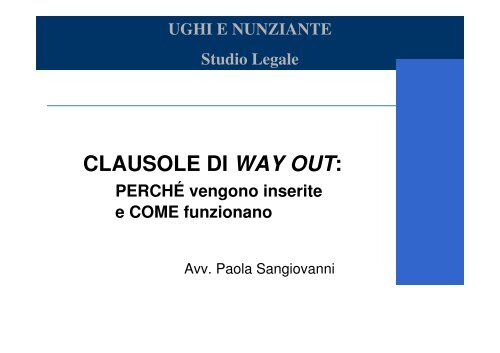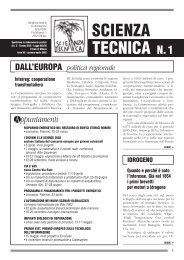CLAUSOLE DI WAY OUT: - Fast
CLAUSOLE DI WAY OUT: - Fast
CLAUSOLE DI WAY OUT: - Fast
Create successful ePaper yourself
Turn your PDF publications into a flip-book with our unique Google optimized e-Paper software.
UGHI E NUNZIANTE<br />
Studio Legale<br />
<strong>CLAUSOLE</strong> <strong>DI</strong> <strong>WAY</strong> <strong>OUT</strong>:<br />
PERCHÉ vengono inserite<br />
e COME funzionano<br />
Avv. Paola Sangiovanni
I fattori in gioco<br />
1) PROGETTO (SOCIETÀ)<br />
2) INVESTITORE (SOCIO)<br />
3) PIANO STRATEGICO CON<strong>DI</strong>VISO<br />
4) REN<strong>DI</strong>MENTO ATTESO IN UN<br />
DETERMINATO PERIODO <strong>DI</strong> TEMPO<br />
Gli investitori nel progetto devono<br />
contemplare la possibilità<br />
di uscirne<br />
UGHI E NUNZIANTE<br />
Studio Legale
Perché le clausole di way out<br />
l’INVESTIMENTO<br />
MINORANZA MAGGIORANZA<br />
UGHI E NUNZIANTE<br />
Studio Legale
Investimento di maggioranza<br />
PIENO<br />
controllo<br />
della<br />
Società:<br />
decisionale (può (può nominare il il<br />
CdA), informativo (sa (sa cosa<br />
succede), sulle sulle operazioni<br />
straordinarie (p.es. aumento di di<br />
capitale, che che porta a diluizione)<br />
UGHI E NUNZIANTE<br />
Studio Legale
Investimento di minoranza<br />
• Non ci sono protezioni derivanti da Codice<br />
Civile: ogni protezione va contrattualmente<br />
negoziata. Es:<br />
– Informazioni sulla società;<br />
– Quorum qualificati in assemblea per certe delibere;<br />
– Protezione antidiluizione; ecc.<br />
UGHI E NUNZIANTE<br />
Studio Legale
Way Out = disinvestimento<br />
<strong>WAY</strong> <strong>OUT</strong> = meccanismo con cui un socio<br />
regola il proprio disinvestimento in una<br />
società<br />
• QUANDO? Il meccanismo deve essere<br />
attivabile al verificarsi di un determinato<br />
evento (TRIGGERING EVENT) ed entro un<br />
certo periodo di tempo (TIME FRAME)<br />
• A CHE PREZZO? Il disinvestimento deve<br />
avvenire ad un corrispettivo predeterminato<br />
sulla base di una formula<br />
UGHI E NUNZIANTE<br />
Studio Legale
Tipi di Way Out<br />
1. Quotazione in borsa = LISTING<br />
2. Cessione a terzi = TRADE SALE (può<br />
includere clausole di co-vendita, come TAG<br />
ALONG o DRAG ALONG)<br />
3. Cessione agli altri soci, p.es.:<br />
1. PRELAZIONE<br />
2. PUT OPTION / CALL OPTION<br />
4. Liquidazione<br />
UGHI E NUNZIANTE<br />
Studio Legale
(1) Es. di clausola LISTING<br />
“The Shareholders undertake to make their best efforts in<br />
order to have the Company listed in one or more regulated<br />
markets to be decided, within twenty four (24) months<br />
elapsing as of the Closing Date. The Shareholders<br />
acknowledge that the Global Offering may include an offer<br />
for the sale of the Shareholdings owned by the<br />
Shareholders, and that the Investors:<br />
– shall have first the right to sell up to a maximum of the<br />
40%, of their Shareholdings in the Company;<br />
– will sell their Shareholdings solely in the institutional<br />
offering;<br />
– will not be bound to grant any representation and<br />
warranty regarding the Company and/or their sold<br />
Shareholdings; and<br />
– will not be bound to agree on any restriction to the sale<br />
of its Shareholdings, save for the applicable restrictions<br />
as manadatorily set forth by the law regulating the<br />
market on which the Company is listed”.<br />
UGHI E NUNZIANTE<br />
Studio Legale
(2) Trade sale: TAG ALONG<br />
• TAG ALONG RIGHT:“diritto all’inseguimento”<br />
• Diritto dei soci di minoranza di vendere la<br />
propria partecipazione contestualmente alla<br />
vendita del socio di maggioranza (il terzo<br />
acquista contestualmente maggioranza e<br />
minoranza)<br />
• Diritto della minoranza per evitare di rimanere<br />
prigionieri della propria quota, difficilmente<br />
cedibile<br />
• Il socio di maggioranza deve procurare che il<br />
terzo acquisti anche la minoranza<br />
UGHI E NUNZIANTE<br />
Studio Legale
(2) Es. di clausola TAG<br />
ALONG<br />
“In the event that a quotaholder (“Offering Holder”)<br />
intends to dispose, in whole or in part, of its quota<br />
holdings (the “Offered Quota”), to any third party,<br />
such Offering Holder, within ten (10) business days<br />
from the expiry of the term provided for by under<br />
Section 3.2(d) (“Tag Along Period”), shall give XY a<br />
written notice thereof (the “Tag Along Notice”),<br />
disclosing the terms and conditions of the proposed<br />
disposal (including the transfer price and the identity of<br />
the third party (the “Proposed Transferee”). XY shall<br />
have ten (10) business days from the expiry of the Tag<br />
Along Period to notify the Offering Holder in writing of<br />
XY’s intention to exercise this tag along right (the “Tag<br />
Along Demand”), which exercise shall be irrevocable.<br />
If XY delivers a Tag Along Demand, XY shall have the<br />
right to transfer to the Proposed Transferee identified<br />
in the Tag Along Notice, XY’s quota holdings at a price<br />
and under terms identical to the Offering Holder and in<br />
all cases no less favorable than identified in the Tag<br />
Along Notice.”<br />
UGHI E NUNZIANTE<br />
Studio Legale
(2) Trade sale: DRAG ALONG<br />
• DRAG ALONG RIGHT: “diritto di trascinare”<br />
• Diritto del socio di obbligare gli altri soci a<br />
vendere contestualmente la propria quota a<br />
un terzo<br />
• Di solito in favore del socio di maggioranza<br />
• È un’opzione di acquisto che viene incontro<br />
all’interesse del socio di maggioranza ad un<br />
potere contrattuale con il terzo più elevato, in<br />
quanto può negoziare la vendita del 100%<br />
della società<br />
UGHI E NUNZIANTE<br />
Studio Legale
(2) Es. di clausola DRAG<br />
ALONG<br />
“Qualora XXYY intenda trasferire, in tutto o<br />
in parte, a terzi le proprie azioni, potrà<br />
richiedere a ZZ che ZZ offra in vendita al<br />
terzo anche le azioni di sua proprietà alle<br />
medesime condizioni proposte dal terzo per<br />
l’acquisto delle azioni di XXYY. In tale<br />
ipotesi, ZZ sarà tenuta a cedere al terzo o a<br />
XXYY la propria partecipazione alle<br />
medesime condizioni proposte dal terzo per<br />
l’acquisto delle azioni di XXYY.”<br />
UGHI E NUNZIANTE<br />
Studio Legale
(3) Cessione a soci:<br />
Clausole di PRELAZIONE<br />
• PRELAZIONE: obbligo del socio che vende<br />
di offrire le proprie azioni agli altri soci alle<br />
stesse condizioni offerte dal terzo potenziale<br />
acquirente protegge l’interesse dei<br />
soci a non avere terzi non desiderati nella<br />
compagine sociale<br />
diritto dei soci di essere preferiti a<br />
qualunque terzo a parità di termini e<br />
condizioni<br />
UGHI E NUNZIANTE<br />
Studio Legale
(3) Cessione ai soci: es. di<br />
PRELAZIONE<br />
“ Il Socio che intenda alienare in tutto o in<br />
parte, le sue azioni ne dà comunicazione per<br />
lettera raccomandata (indicando il nominativo<br />
e l'indirizzo o sede dell'acquirente, il numero<br />
delle azioni alienande, il loro prezzo e le<br />
condizioni di pagamento) agli altri Soci entro<br />
15 (quindici) giorni per lettera raccomandata.<br />
Le azioni si intendono offerte in prelazione<br />
agli altri Soci, al medesimo prezzo e<br />
condizioni ”.<br />
(può includere meccanismo di revisione prezzo)<br />
UGHI E NUNZIANTE<br />
Studio Legale
(3) Cessione a soci:<br />
Put / Call Option<br />
• PUT OPTION = opzione di vendita<br />
• CALL OPTION = opzione di acquisto<br />
1. Condizioni per l’esercizio<br />
2. Prezzo di acquisto / vendita<br />
• PUT and CALL simultanee o gradate<br />
• Anche in caso di deadlock (o stallo)<br />
UGHI E NUNZIANTE<br />
Studio Legale
(3) Cessione a soci: es. put /<br />
call<br />
• Opzione di Vendita o PUT: “XXYY avrà il<br />
diritto irrevocabile di vendere tutte, ma non<br />
una parte di, le Azioni Soggette ad Opzione a<br />
ZZ, che sarà tenuta, corrispondentemente,<br />
ad acquistare da XXYY dette Azioni”<br />
• Opzione di Acquisto o CALL: “AA avrà il<br />
diritto irrevocabile di acquistare tutte, ma non<br />
una parte di, le Azioni di proprietà di BB, la<br />
quale sarà tenuta, corrispondentemente, a<br />
vendere ad AA dette Azioni”.<br />
UGHI E NUNZIANTE<br />
Studio Legale
CONCLUSIONI<br />
• Le clausole di <strong>WAY</strong> <strong>OUT</strong> servono a gestire in<br />
modo ordinato e non contenzioso il<br />
disinvestimento<br />
• Meccanismi tecnici per lo più a tutela<br />
dell’investimento della minoranza<br />
• Niente paura: se la formula è corretta, la way<br />
out consente di diventare felicemente “serial<br />
enterpreneurs”!<br />
UGHI E NUNZIANTE<br />
Studio Legale
GRAZIE PER L’ATTENZIONE!<br />
Domande?<br />
PSANGIOVANNI@UNLAW.IT<br />
UGHI E NUNZIANTE<br />
Studio Legale





